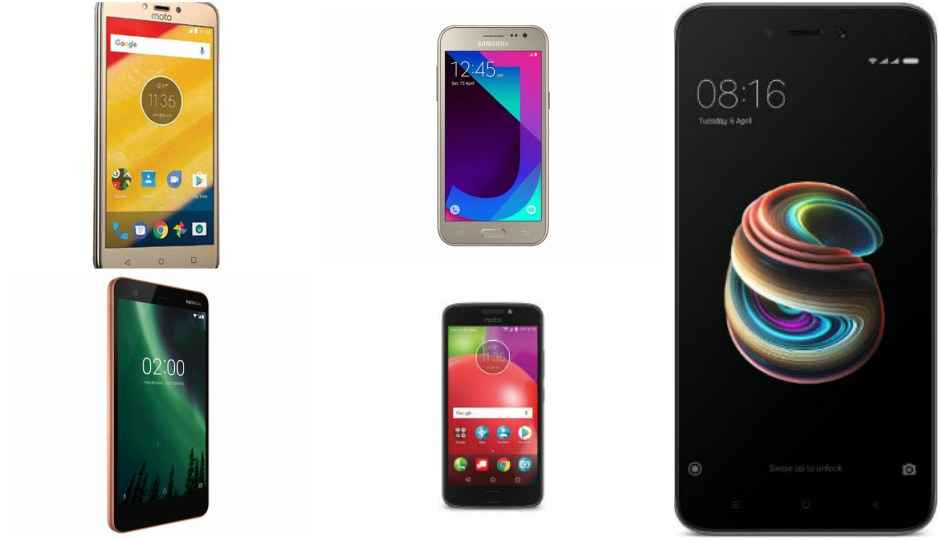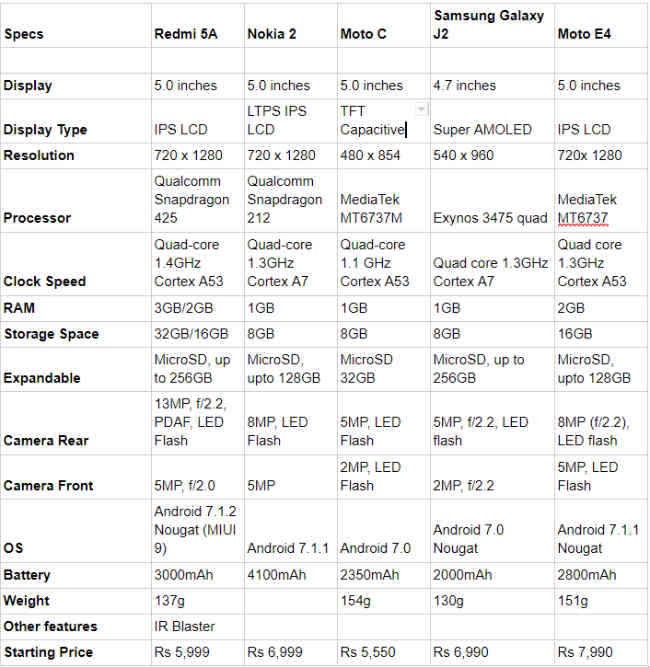Xiaomi Redmi 5A specs compared with Nokia 2, Moto C, Samsung Galaxy J2 and Moto E4
During the launch of the Xiaomi Redmi 5A in India, Country head and global VP, Manu Kumar Jain mentioned a few phones which he thinks are competition. So we took it upon ourselves to compare the specs of all those devices, and some more, with the Redmi 5A. Here's how the phones stack up against each other.

Xiaomi launched the Redmi 5A, aka, “Desh ka Smartphone” in India for prices starting at Rs 5,999, making it the cheapest budget smartphone running Android Nougat in the market. Moreover, Xiaomi even announced a Rs 1000 discount for the first 5 Million buyers of the Redmi 5A 2GB RAM, 16GB ROM version.
 Survey
SurveyThe Redmi 5A is basically a minor upgrade over the previous Redmi 4A, but is priced cheaper than that. What’s more, the phone aims to take on entry-level competition which has heated up significantly this year with the entry of the Nokia 2, launched earlier this month.
Xiaomi even mentions its competition by their names to show how the Redmi 5A categorically wins against them. So we took the spec sheets of all the entry-level Android phones Xiaomi mentioned during the launch of the Redmi 5A to see if there is any truth in the company’s claims.
Truth be told, the entry-level Android phone segment is mired by companies trying to cut corners to bring down their costs. As a result, there are a lot of claims that phone makers make, but fail to live up to them. Hence, it all comes down to how much a phone maker is willing to compromise.
Display and Design
The Redmi 5A’s, when pitted against the competition only loses out to the Samsung Galaxy J2 which uses Samsung’s own Super AMOLED display. The rest of the competition relies on IPS LCD panels same as the Redmi 5A, save for the Moto C which uses an inferior TFT display. However, the Galaxy J2 has a lower screen resolution than the Redmi 5A. Hence, even though the J2’s display has more vibrant and dynamic colours, there are more details in the Redmi 5A. The Moto C, in this category, has the most inferior display with a 480 x 854 pixel resolution.
Also, the Redmi 5A sports a matte metal finish, while the Nokia 2 and the Moto E4 sports a combination of metal and polycarbonate and the rest of the competition relies on plastic. Hence, the build quality of the Redmi 5A is hands down more superior than the rest.
Hardware
Here again, the Redmi 5A has undercut the competition. At the entry-level segment, only the Redmi 4A is powered by the Qualcomm Snapdragon 425 processor, a Quad-core chipset offering a clock speed of 1.4Ghz. In comparison, only the Moto C comes out severely underpowered owing to its Quad-core MediaTek MT6737M chipset clocked at 1.1GHz. Samsung uses its proprietary Exynos 3475 while the Nokia 2 relies on a Snapdragon 212 processor, both clocked at 1.3GHz. The Moto E4 is also powered by a MediaTek processor clocked at 1.3Ghz.
Now, the MediaTek vs Snapdragon debate is fast becoming irrelevant in the flagship category, but there are still areas where MediaTek is quite inferior to Snapdragon chipsets when it comes to the budget range. MediaTek uses off-the-shelf ARM cores while Snapdragon relies on the ARM architecture but optimises more to make it more power efficient.
Here too, the Redmi 5A has an edge over the rest. The gap between Xiaomi’s offering and the rest of the competition becomes more apparent when the RAM and the storage is taken into consideration. The lowest variant of the Redmi 5A comes with 2GB of RAM which is more than what everyone except Moto E4 offers. In terms of storage too, the Redmi 5A comes out as the winner with 16GB of storage in the lowest variant going all the way up to 32GB which is again coupled with 3GB of RAM. The entire competition offers expandable storage, but only the Redmi 5A offers a dedicated microSD slot which is only matched by the Moto E4 and the Moto C.
One other thing that the Redmi 5A has, which no one else offers at that price, is perhaps one of the most useful, yet understated feature in a smartphone — An IR blaster.
Software
This is where things get a bit controversial. 2017 has been all about stock Android and even in the entry-level segment, majority of the offerings have stock Android 7.0 Nougat in them. The Nokia 2, the Moto C, the Moto E4, all of them. Only the Samsung J2 and the Redmi 5A offer their own custom UI. Truth be told though, MIUI 9 is packed with more features while stock Android Nougat is generally more snappy and fast. Both MIUI 9 and Samsung’s TouchWiz are resource intensive and considering none of the phones have high processing power, stock Android is the ideal option to have.
Here, the Nokia 2 offers the latest Android 7.1.1 Nougat with the promise of an upgrade to Android 8.0 Oreo. The Moto C and the Moto E4 also run on stock Android Nougat, but there has been no word on when an update might come for them.
Camera
Xiaomi built its name on offering imaging prowess better than its immediate competition. The same stands for the Redmi 5A, which on paper, has the hardware to shoot better photos as compared to the rest of the competition. The Redmi 5A has a 13-megapixel camera on the back with f/2.2 aperture and phase detection autofocus. This is the most an entry-level phone is offering currently, with the Nokia 2 and the Moto E4 coming second with an 8-megapixel camera on the back. The rest of them are fitted with a 5-megapixel sensor on the back, which is definitely not at par with what Xiaomi is offering.
On the front, the Redmi 5A has a 5-megapixel camera while both the Moto C and Samsung J2 has 2-megapixel shooters (albeit with front flash in the case of Moto C). The Nokia 2 and the Moto E4 also sport a 5-megapixel front camera.
Battery
When it comes down to the battery capacity, the Nokia 2 demolishes the entire competition with its 4,100mAh battery which Nokia claims can last for two days straight. It wouldn’t be surprising if it does though, considering Nokia is on stock Android which is not too taxing on the processor.
In comparison, the Redmi 5A has a 3,000mAh battery which Xiaomi claims has an idle standby time of 8 days. That metric will change drastically once MIUI is put to use as Xiaomi’s interface is quite taxing on the processor and will perhaps take away the advantage Xiaomi has over the others in terms of numbers.
Price
The Xiaomi Redmi 5A is by far the cheapest entry-level Android phone out there. It starts from an unbeatable price of Rs 5,999. But Xiaomi is offering the phone for Rs 1,000 less for the first 5 million buyers. So effectively, if you buy the phone right now, the Redmi 5A will only be for Rs 4,999. The price is currently matched only by Moto C, which retails for Rs 5,550. But considering the compromises the Moto C makes in terms of the hardware, it is logical to put in Rs 500 more for the Redmi 5A. The Moto E4 is by far the most expensive at Rs 7,999. At that price, there is the Redmi 4 which once again categorically demolishes the competition.
